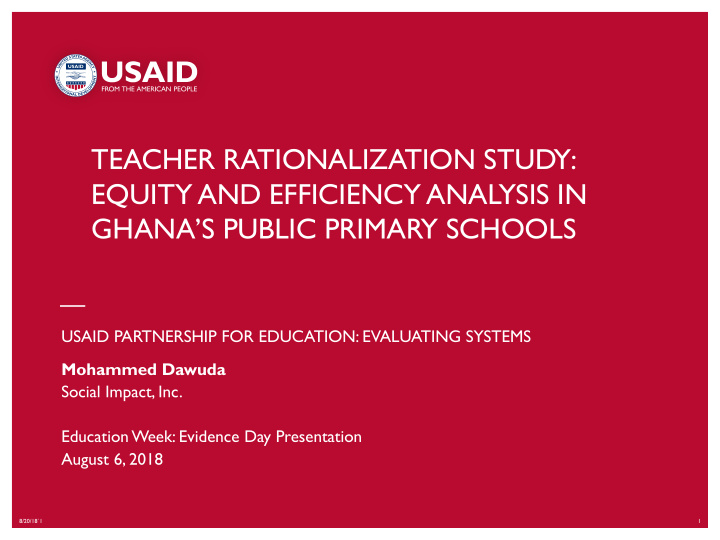



TEACHER RATIONALIZATION STUDY: EQUITY AND EFFICIENCY ANALYSIS IN GHANA’S PUBLIC PRIMARY SCHOOLS USAID PARTNERSHIP FOR EDUCATION: EVALUATING SYSTEMS Mohammed Dawuda Social Impact, Inc. Education Week: Evidence Day Presentation August 6, 2018 8/20/18`1 1
PURPOSE OF THE STUDY • Demand-Driven Study • To produce evidence-based recommendations to enable the MOE and GES improve and implement policies related to the rationalization, deployment, and retention of teachers in line with Ghana’s LOI policy 8/20/18 FOOTER GOES HERE 2
METHODOLOGY National Situation Analysis Regional Study (September 2017-February (September 2018- 2018) October 2018) • Analysis of existing datasets • In-depth district case-studies such as EMIS, IPPD, EGRA to examine context- and SRC. specific issues and • Interviews with key challenges stakeholders and policy • Interviews with district and makers. circuit officials, as well as • Present initial findings to head teachers and teachers. T eacher Rationalization Study • Collaboratively develop set Working Group (TRSWG) of short- medium- and and finalize plan for regional longer-term data collection. recommendations with TRSWG based on report findings 8/20/18 FOOTER GOES HERE 3
INITIAL NATIONAL LEVEL KEY FINDINGS 1. Pupil-T eacher Ratio (PTR) and Class-T eacher Ratio (CTR) figures at the national level mask severe inequities and inefficiencies in teacher resourcing at the regional and district levels. 8/20/18 FOOTER GOES HERE 4
Regional level PTR Inequities 8/20/18 FOOTER GOES HERE 5
District Level Inequities SY 16/17 KG & Primary PTR, by District Acute Surplus (<15:1) Mild Surplus (15:1-25:1) Near Target (25:1-35:1) Mild Shortage (35:1-45:1) Acute Shortage (>45:1) 8/20/18 FOOTER GOES HERE 6
Intra-District Efficiency Inefficiency: Districts that contain schools with BOTH acute shortage and acute surplus so teachers can be redistributed within the district to meet target PTR The dark shared areas are districts that are inefficient in teacher deployment 8/20/18 FOOTER GOES HERE 7
INITIAL NATIONAL LEVEL FINDINGS Cont. The TRS report goes more in-depth into the following findings. These are initial findings that will be further investigated in the Regional Study 2. Teacher • Shortages of teachers in rural and underserved areas are largely due to lack of social amenities, inadequate Shortage—Rural & facilities, poor condition of service and the perception Underserved areas that the teaching profession is not attractive 3. Inadequate Policies • Policies and procedures on teacher deployment and retention are understood differently by managers of & Procedures education • EMIS has rich data available for analysis. The study 4. EMIS Data identified key areas for further improvement (missing data, difficulty when integrating with other data sources) 8/20/18 FOOTER GOES HERE 8
WHAT NEXT? Building on the national findings, the regional analysis will go more in-depth to examine context specific issues that emanated from the national situation analysis report. September 2018 to October 2018 Conduct Case Studies in 10 selected districts December 2018 Develop Final Report, policy recommendations, and dissemination Ongoing • Utilization of Results: TRS Working Group training on presenting TRS Study results and policy change advocacy 8/20/18 FOOTER GOES HERE 9
End of Presentation. THANK YOU QUESTIONS? Access the draft report 8/20/18`1 10
Recommend
More recommend